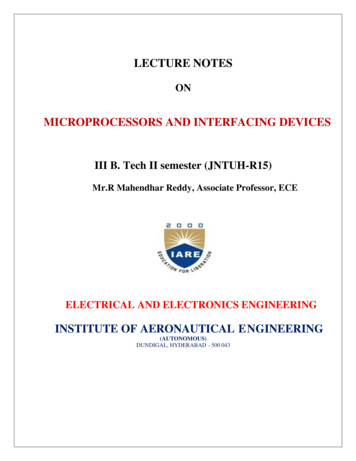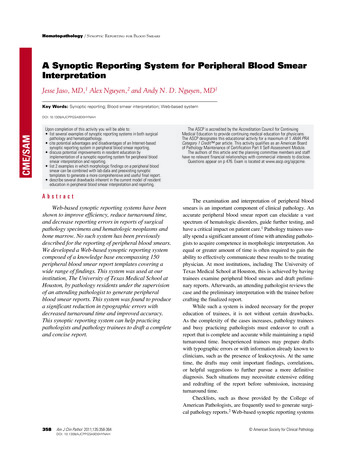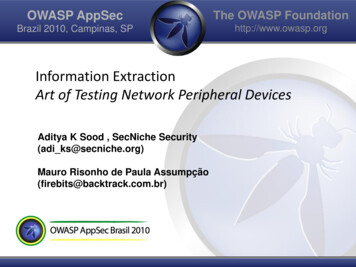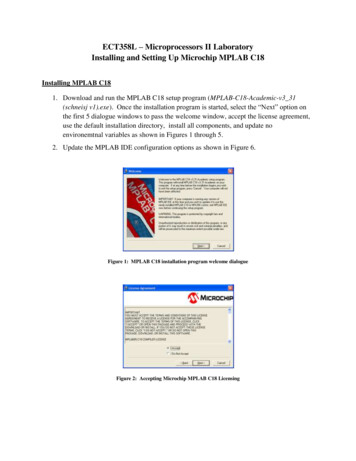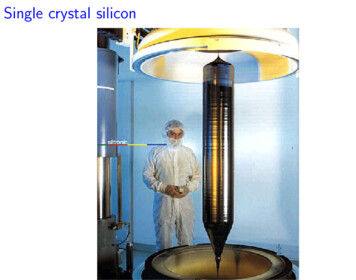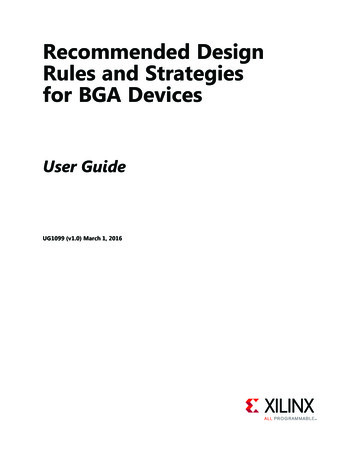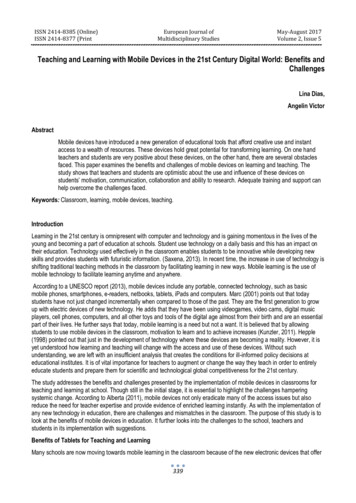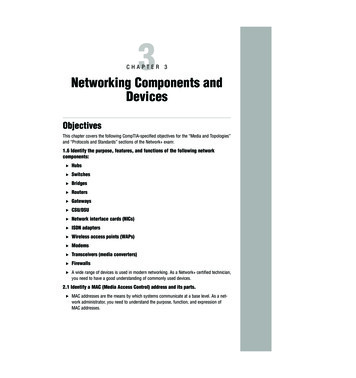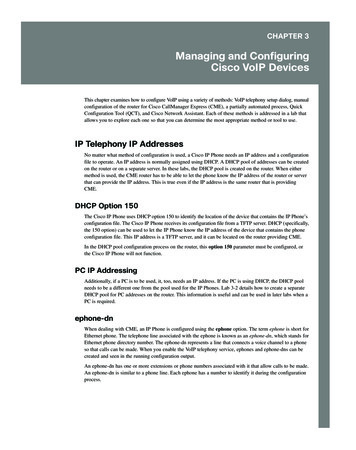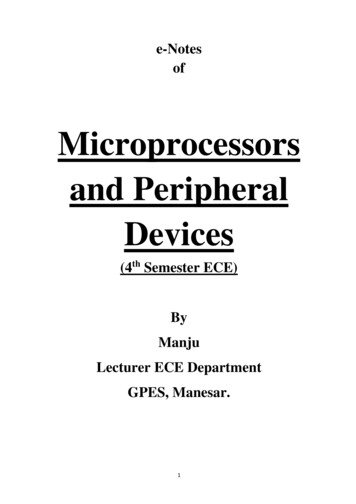
Transcription
e-NotesofMicroprocessorsand PeripheralDevices(4th Semester ECE)ByManjuLecturer ECE DepartmentGPES, Manesar.1
Chapter 1Evolution of MicrocomputerIntroductionA microprocessor is a programmable electronics chip that has computing and decision makingcapabilities similar to central processing unit of a computer. Any microprocessor based systems havinglimited number of resources are called microcomputers. Nowadays, microprocessor can be seen inalmost all types of electronics devices like mobile phones, printers, washing machines etc.Microprocessors are also used in advanced applications like radars, satellites and flights. Due to the rapidadvancements in electronic industry and large scale integration of devices results in a significant costreduction and increase application of microprocessors and their derivatives.Microprocessor-based system Bit: A bit is a single binary digit.Word: A word refers to the basic data size or bit size that can be processed by the arithmetic andlogic unit of the processor. A 16-bit binary number is called a word in a 16-bit processor.Bus: A bus is a group of wires/lines that carry similar information.System Bus: The system bus is a group of wires/lines used for communication between themicroprocessor and peripherals.Memory Word: The number of bits that can be stored in a register or memory element is called amemory word.Address Bus: It carries the address, which is a unique binary pattern used to identify a memorylocation or an I/O port. For example, an eight bit address bus has eight lines and thus it canaddress 28 256 different locations. The locations in hexadecimal format can be written as 00H –FFH.Data Bus: The data bus is used to transfer data between memory and processor or between I/Odevice and processor. For example, an 8-bit processor will generally have an 8-bit data bus and a16-bit processor will have 16-bit data bus.Control Bus: The control bus carry control signals, which consists of signals for selection ofmemory or I/O device from the given address, direction of data transfer and synchronization ofdata transfer in case of slow devices.2
A typical microprocessor consists of arithmetic and logic unit (ALU) in association with control unit toprocess the instruction execution. Almost all the microprocessors are based on the principle ofstore-program concept. In store-program concept, programs or instructions are sequentially stored in thememory locations that are to be executed. To do any task using a microprocessor, it is to be programmedby the user. So the programmer must have idea about its internal resources, features and supportedinstructions. Each microprocessor has a set of instructions, a list which is provided by the microprocessormanufacturer. The instruction set of a microprocessor is provided in two forms: binary machine code andmnemonics.Microprocessor communicates and operates in binary numbers 0 and 1. The set of instructions in theform of binary patterns is called a machine language and it is difficult for us to understand. Therefore, thebinary patterns are given abbreviated names, called mnemonics, which forms the assembly language.The conversion of assembly-level language into binary machine-level language is done by using anapplication called assembler.Technology Used:The semiconductor manufacturing technologies used for chips are: Transistor-Transistor Logic (TTL) Emitter Coupled Logic (ECL) Complementary Metal-Oxide Semiconductor (CMOS)Classification of Microprocessors:Based on their specification, application and architecture microprocessors are classified.Based on size of data bus: 4-bit microprocessor 8-bit microprocessor 16-bit microprocessor 32-bit microprocessorBased on application: General-purpose microprocessor- used in general computer system and can be used byprogrammer for any application. Examples, 8085 to Intel Pentium. Microcontroller- microprocessor with built-in memory and ports and can be programmed for anygeneric control application. Example, 8051. Special-purpose processors- designed to handle special functions required for an application.Examples, digital signal processors and application-specific integrated circuit (ASIC) chips.Based on architecture: Reduced Instruction Set Computer (RISC) processors Complex Instruction Set Computer (CISC) processorsThe concept and architecture of a microcomputerA microcomputer is a computer built on the basis of a microprocessor i.e. a processor implemented asan integrated circuit. Since all processors are now produced in the form of integrated circuits, we can3
say that all computers are microcomputers. The general method for constructing microcomputersconsists in connecting to the microprocessor busses additional sub-systems such as memories andperipheral device controllers (input/output units).The basic block diagram of a simple microcomputer is shown in the figure below. We can see there amicroprocessor with three its busses going out: data bus, address bus and control bus. To these busses,the following devices are connected: operational memory composed of RAM (Random AccessMemory)and ROM (Read Only Memory) memories, as well as input/output units to which peripheraldevices are connected.Simple microcomputerA more developed block diagram of a microcomputer is shown in the figure below. Besides RAM andROM memories, more input/output units are connected to the microprocessor.These input/output units include: parallel input/output controller in short - parallel I/O, parallel interface serial input/output controller in short - serial I/O, serial interface interrupt controller (handler) timer/counter controller Direct Memory Access (DMA) controller4
General scheme of simple microcomputerParallel input/output controller maintains information exchange with peripheral devices, which senddata in the parallel form. Examples of such devices are printers, display monitor, hard and floppy diskmemories, keyboard. The activity of the controller is supervised by the microprocessor, whichintervenes on each transfer of data by execution of respective instructions of data read or write from (to)the controller. The controller itself transfers data from its internal memory (registers) to peripheraldevices.The serial input/output controller maintains information exchange with peripheral devices, whichsend data in the serial form. Examples of such devices are a mouse and a modem for interconnectionsthrough telephone network. The controller implements in hardware conversion of serial data into theirparallel form and vice versa (with the use of serial/parallel registers). The functioning of the controlleris controlled by the microprocessor, which intervenes on each termination of data conversion byexecution of respective data read or writes instructions.Interrupt controller provides servicing interrupts coming in parallel from many external devices. Itstask consists in receiving interrupt requests, registering them, performing selection to choose onewhich is to be serviced by the processor. The controller communicates with the processor to enablesending the identifier of the selected interrupt and to exchange control signals. The interrupt controlleris supervised by the processor, which services the interrupt after receiving the interrupt from thecontroller.The DMA controller enables parallel data exchange between external devices and the operationalmemory without involvement of the processor. This controller enables autonomous data transfersto/from operational memory. These transfers do not engage the processor, which can proceed withcomputations at the same time.5
The Microprocessor's Impact on SocietyToday, we literally swim in a sea of silicon. There are dozens of chips in every car and dozens in everyoffice. Microprocessors in the form of watches, pagers, cellular phones, and Sharp Wizard's adorn ourbodies as jewelry. Beyond embedded systems, the rapid rise of the Internet now appears to be on theverge of ensuring that the personal computer truly becomes ubiquitous. Where in the past PCs have beenconcentrated in the workplace and scattered in the homes of the wealthier third of American society, theInternet is almost certain to lower the final obstacles and make it possible to create a new class ofinformation appliances that will extend the reach of the Net until it matches that of television or thetelephone. Microprocessors are everywhere, but how is modern life different? In many areas the adventof microelectronics obviously does have clear benefits. That can be seen in the effect of computingtechnology on the disabled; the transformation of certain kinds of boring and dangerous manual labor;advances in medical technology and weather forecasting. Indeed the easy answer is that microprocessorshave transformed modern society. They affect the way we work and play, the way we travel andcommunicate. They offer remarkable processing power at infinitesimal cost.6
Chapter 2Architecture of MicroprocessorA bus is a collection of wires, chips and slots inside the computer through which data are transmittedfrom one part of the computer to another from peripheral devices. It is also called a pathway in thecomputer on which data travels. It is a set of parallel distinct wires, serving different purposes, whichallow devices attached to it to communicate with the CPU.The bus architecture in computer system is as shown below:Bus architectureThe functions of BUS are: It carries information from one component to another. It carries data, address or control signal. One component of the computer can interact with other through a bus. There are three main part of bus.They are described below:Control Bus:It carries the control signal. The control signal is used for controlling and coordinating the variousactivities of the computer. It is generated from the control unit of the CPU. Different architectures resultin a different number of lines within the control bus, as each line is used to perform a specific task.For instance, different specific lines are used for each of read, write and reset requests. These are not agroup of lines like address bus and data bus, but individual lines that provide a pulse to indicate amicroprocessor operation. The control unit generates a specific control signal for every operation, suchas memory read or input/output operation. This signal is also used to identify a device type, with whichthe microprocessor intends to communicate.7
Control busAddress Bus:Address bus carries memory address within the device. It allows the CPU to reference memory locationswithin the device. It connects the CPU and other peripherals and carries only memory address. In acomputer system, each peripheral or memory location is identified by a numerical value, called anaddress and the address bus is used to carry this numerical value as well as it also contains a few controllines to carry control commands. The address bus is unidirectional, bits flow in one direction from theprocessor to peripherals.The processor uses the address bus to perform the first function of identifying a peripheral or a memorylocation. The address bus contains the connections between the processor and memory that carry thesignals relating to the address which the CPU is processing at that time, such as the locations that theCPU is reading from or writing to. The processor uses the address bus to perform, identifying aperipheral or a memory location.When the address bus carries 8 bit at a time, the CPU could address only 256 (i.e. 28) bytes of RAM.Most of the early PCs had 20 bit address buses. So, CPU could address 220bytes of data. Now, with32-bit address buses, CPU can address 4GB of RAM. If there is wider bus path, more information can beprocessed at a time and hence, it also affects the processing speed of a computer.Address busData Bus:Data bus transfer data from one location to another across the computer. On these lines, the meaningfuldata which is to be retrieved from a device is placed. Data bus is used by CPU to transfer data. It may be16-bit or 32-bit data bus. It is an electrical path that connects the CPU, memory and other hardwaredevices on the motherboard. These lines are bidirectional in which the data flows in both directionsbetween the processor and memory and peripheral devices. The number of wires in the bus affects thespeed at which data can be travel between hardware components just as the number of lanes on ahighway affects the time it takes people to reach their destination. Each wire can transfer 1 bit of data ata time and 8 wire bus can move 8 bit at a time, which is 1-byte data at a time. A 16-bit bus can transfer 28
bytes. 32 bits can transfer 4 bytes and so on. Intel 80286 microprocessor used16 bit data bus and Intel80386 used 32-bit data bus. When the data bus width grows larger, more data can be transferred.The transmission of the data on bus lines takes place between approximately 1M baud for themicrocomputer to about 1000 M baud or more for the large more expensive computers (1 baud 1bit/sec). Communication between the different units of a processing system is carried out along addressand data bus and also along various control lines. All control operations are governed by the mastertiming source and clock.data busBus organization of 8085The microprocessor MPU performs various operations with peripheral devices or a memory locationby using three sets of communication lines called buses: the address bus, the data bus and the controlbus. And these three combined lines is called as system bus.Bus structureAddress bus:The address bus is a group of 16 lines generally called as A0 – A15 to carry a 16-bit address ofmemory location. In a computer system, each peripheral or memory location is identified by a binarynumber called an address. This is similar to the postal address of a house. The address bus isunidirectional, that means bit flow in only one direction from MPU to periph
1. microprocessor will transfer 16 bit address from PC to address line to select desired location 2. Microprocessor gives reading location so 8 bit instruction is transferred from selected memory location to data pin 3. instruction code is transferred by mi9croprocessor to instruction register from data bus.
